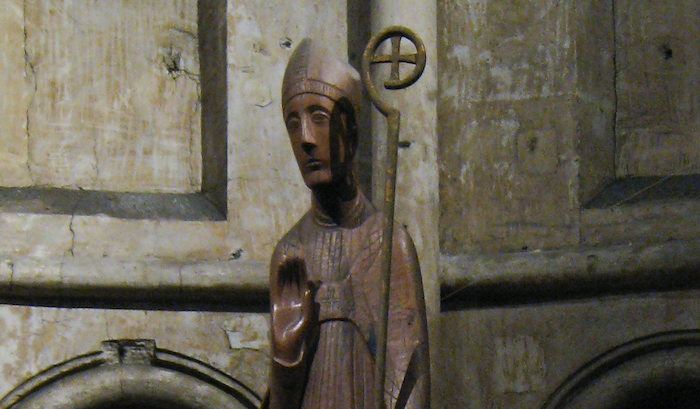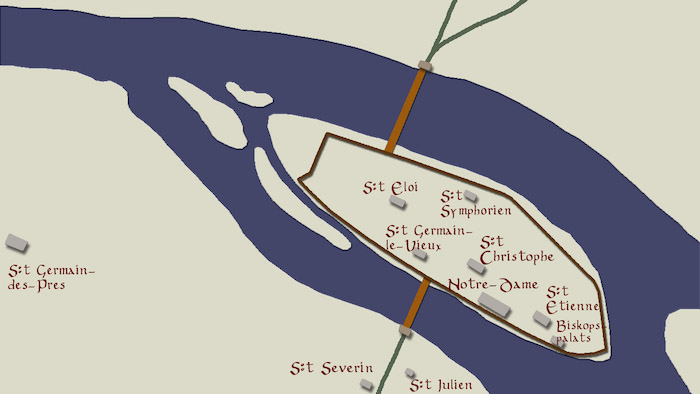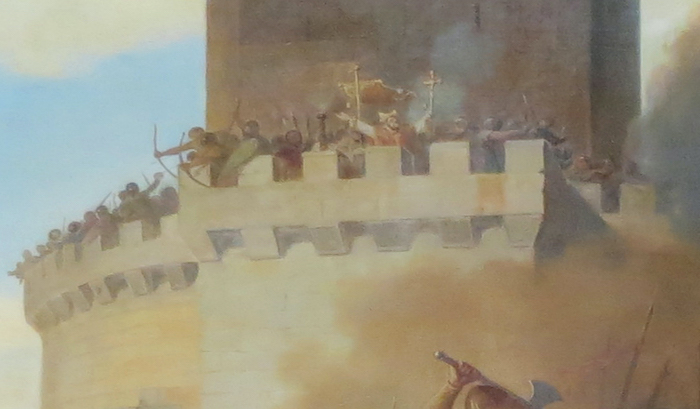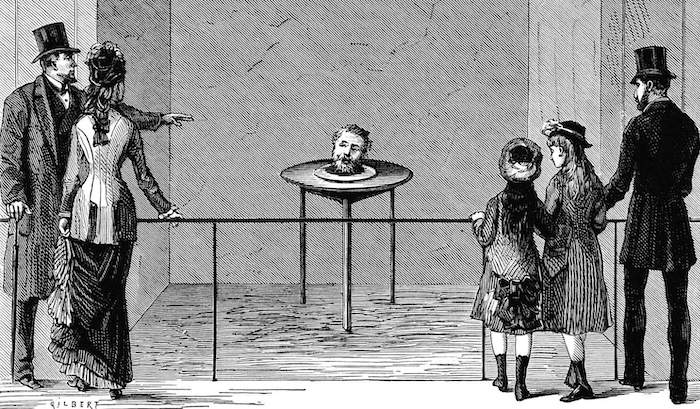Through much of 885 and 886 A.D., a large force of raiders from Scandinavia besieged Paris. An eyewitness account of the Viking siege has survived: the Bella Parisiacae Urbis (Battle of the City of Paris) by Abbo, a monk of the abbey of Saint-Germain-des-Prés. Brother Abbo did not seek to produce a literal and accurate accounting of precisely what he witnessed from the walls of Paris. Instead, his epic poem recounts what Abbo saw as the truth behind the truth: how God’s foremost servant, St. Germain, protected the Christian city of Paris from polytheists deluded by Satan into tearing down Christendom. The Bella is full of surprise miracles, including appearances in the flesh by the long-dead St. Germain. It’s more a long poem of magical realism than a history text. It’s also a really interesting demonstration of how to use divine intervention in RPG adventures in a way that feels satisfying, not arbitrary.
This post is brought to you by beloved Patreon backer Colin Wixted. Thanks for helping keep the lights on! If you want to help keep this blog going alongside Colin, head over to the Patreon page – and thank you!

Image credit: Sharon Mollerus, released under a CC BY 2.0 license.
The real hero of this story isn’t Brother Abbo, but St. Germain. The saint was the bishop of Paris in the 500s A.D. He demonstrated all the requisite Christian virtues in life, and after his death people reported miracles when they prayed to him to intercede with God on their behalf. He became one of the first patron saints of Paris. The abbey dedicated to him, Saint-Germain-des-Prés, was near Paris and contained the saint’s limbs as a holy relic. During St. Germain’s lifetime, Paris was the capital of the Kingdom of the Franks, but the next royal dynasty moved the capital elsewhere. By the time the Vikings came to call, Paris was still an important Frankish city, but its loss wouldn’t imperil the kingdom.
This raid in 885 was part of a broader pattern of Viking raids, where armed men from Scandinavia (roughly modern Denmark, Norway, and Sweden) showed up in boats along the coasts and rivers of Europe. They’d loot and take slaves where it was easy, demand tribute money to go away where targets were tougher, and sometimes they’d put down roots and settle. By 885, this pattern had been going on for about a century. The Parisian raid was a loose collection of thousands of Scandinavian warriors led by a multitude of independent chieftains. They wanted to sail upriver past Paris to plunder the Seine river valley, but a pair of bridges stopped their passage. Standard Frankish practice at this point would have been to let the Vikings pass and pay them tribute money if they asked for it. Resisting the Vikings seldom did anyone any good. But the governor of the city, the wonderfully-named Count Odo, declared he’d do no such thing, even though he had far fewer troops than his opponents. The Vikings threatened to take Paris by force, and both sides dug in for a siege.
To Brother Abbo, the Vikings were literal Satanists. In 885, most Scandinavians were, of course, polytheists, practicing some version of the traditional Germanic religion. To the zealous Abbo, that meant the Vikings had been deluded by Satan into worshipping devils and false idols, and were here carrying out the will of Lucifer himself. The struggle between Paris and its besiegers was thus a divine struggle between God and the Devil. It was only natural that God’s best friend, St. Germain, would help the city he’d been bishop of in life and was patron of in death. Brother Abbo thus fills his poem with miracles to illustrate this central truth. It’s a colorful tale. And since it’s a poem written in the meter called ‘dactylic hexameter’, it’s quite literally an epic.

Early in the siege, Abbo’s miracles were mostly minor ones, and didn’t necessarily involve St. Germain. Three Vikings were slain in quick succession in an identical manner (an arrow in the mouth), suggesting the Holy Trinity. God strengthened the resolve of the defenders and weakened that of the Vikings. Paris’ bishop fired an arrow at one particularly capable besieger, and the arrow passed through the Viking’s shield, slaying him in a manner reminiscent of a psalm. A cart full of plunder from the Parisian suburbs got stuck in the mud to an improbable degree. And in the funniest miracle, a Viking chieftain declared that he would stay as long as it took to win; he’d rather camp on the bottom of the Seine River than leave France. Shortly thereafter his boat capsized and he drowned. God very politely helped him keep his promise.
But things started getting wild when the Vikings tried to burn one of the bridges over the Seine. Some folks have described this part of the poem as “magical realism.” Abbo, writing over a thousand years before the term was coined, would certainly object. He wasn’t recording supernatural events he claimed to have witnessed or that he claimed to have heard from a reliable source. He was recording events as he felt they were, regardless of what anyone did or didn’t see. This isn’t Expedition Bigfoot shoehorning any evidence they can find into the story they were going to tell regardless. This is simply a totally different way of thinking about the nature of reality and truth.
In the winter of early 886, the Viking besiegers decided they were going to burn one of the bridges over the Seine. Paris’ defenders were holed up on the Île de la Cité, a fortified island in the Seine connected to each bank by a bridge: one stone, one wood. The Vikings were going to get past Paris by burning the wooden bridge. They filled up three ships with branches and leaves. They tied ropes to each ship so Vikings walking along the bank could guide them. Then they set the ships on fire and guided them towards the wooden bridge. The city lamented. The defenders mourned. The walls of the city wept salt tears.

Image credit: Sven Rosborn, released under a CC BY-SA 3.0 license.
In their agony and desperation, the people of Paris called out to their patron, St. Germain, begging him to save them. The whole city, with one throat, called out to the man who had been their most beloved bishop three hundred years before. In heaven, St. Germain begged God to let him go down to Paris and save the city. And God agreed. St. Germain, appearing not yet in the flesh – that will come later – caused the three fire ships to crash not into the timbers of the bridge but into the bridge’s stone foundation. The people of Paris were able to rush down to the foundation, put out the ships with river water, and take them for themselves. The city was saved for another day.
Now that St. Germain was here on earth, he started performing miracles left and right. Crucially, he performed miracles about things that mattered to him, the man Germain of Paris, not necessarily the things that would be most helpful in ending the ongoing siege. These miracles weren’t strategic. They were personal.
I mentioned that St. Germain’s abbey and church were near Paris. This location was particularly important to the saint. One Viking smashed the stained glass windows of the church with a cudgel. St. Germain cursed him, and he died screaming. Another climbed the church’s roof, but St. Germain caused him to place his feet in the wrong place, so he fell off the roof, broke all his bones, and died. Another Viking tried climbing on the roof, but St. Germain sent a gust of wind that carried him to the same fate. A fourth Viking tried opening up the tomb of Germain’s father to loot the grave goods. But the first stone the Viking dislodged shot out and hit him in the chest. He died. A final Viking stole a coverlet from St. Germain’s church to use as a blanket. The saint waited until the thief went to sleep, then caused his body beneath the covers to shrink to the size of a child’s body. The process killed the Viking.
The Vikings tried to use the church of St. Germain as a paddock for their looted livestock. This was so insulting that St. Germain caused all the livestock to die, then he filled their flesh with worms. In so doing, Abbo tells us, St. Germain took up to heaven all that was good about the animals’ flesh in the manner of an Old Testament offering. This rendered the flesh holy, and since the Vikings were unwitting followers of Satan, the holy flesh of the livestock was thus rendered useless to them by way of the worms.

Image credit: DAVID ILIFF, released under a CC BY-SA 3.0 license.
As St. Germain’s feast day approached (May 28th), he grew more active. He finally appeared in the flesh, walking the lands near his abbey church in the form of a glowing figure carrying a lantern. Soon thereafter, he appeared to a sick nobleman in a dream, healed him, and told him that, as Paris’ knightly defenders hadn’t managed to break the siege themselves, he (St. Germain) was taking over the defense of the city. Folks soon took to carrying St. Germain’s casket around the walls of Paris, the same way an earthly general would inspect his fortifications. Once, a Viking sling stone struck one of the saint’s bearers and should have killed him. Instead, the slinger died. When the siege seemed at its most dire, and battle was joined everywhere around the walls and bridges at once, the whole city cried out once more for St. Germain. Even the rivers and fields moaned his name. Then did St. Germain appear in the flesh, in the middle of battle, fighting as a soldier and a champion. He slew the Viking standard-bearers and drove back Satan’s horde.
Yet amidst all these miracles, there were still Viking actions the saint permitted. Remember all those miracles around St. Germain’s church? Abbo takes pains to point out that those miracles were only in retaliation for the mistreatment of the church. As long as the Vikings didn’t desecrate it, St. Germain didn’t have a huge problem with them being there. Indeed, the Vikings turned St. Germain’s church into a fortress, perhaps their central command post. It was, after all, a conveniently-placed and well-constructed building. Abbo declares that St. Germain permitted this so as to shame the defending Franks for their sins. Remember that the Franks, the ethnic group that ruled what is today France during the early Middle Ages, were a Germanic people who participated in Germanic, honor-based traditions. Public shaming was a serious punishment, and old-fashioned St. Germain probably would have taken it even more seriously than 9th-century Franks did. Again, the miracles Abbo describes were personal, and reflected St. Germain’s personality and priorities.
Later in 886, King Charles the Fat appeared with his army. He declined to fight the Vikings, paying them instead 700 pounds of silver to leave France. The Vikings immediately broke their oaths, traveling instead to Burgundy to pillage there. They would soon return to Paris to try again, where they would again be paid off, this time by a new king: Odo, the guy who’d defended Paris the first time around. Abbo viewed this as a grave betrayal by Odo, consistent with the idea that political leaders will always fail you, but divine leaders will always see you through.

What Abbo gives us here isn’t just a great story. It’s a template for how to handle divine intervention in our RPG campaigns. Let’s treat St. Germain as a local demigod or a Sufficiently Advanced technology/species in science fiction. Certainly Abbo does – you’d never see a mainline Catholic theologian today writing about a saint like this. Germain isn’t acting according to some grand divine plan or interceding with God or whatever. He’s acting personally, the way a human would. And as long as you act according to his conception of proper behavior, you’re fine. One gets the impression that as long as the Vikings didn’t act in ways that Abbo would consider improper, St. Germain would’ve let them be. Now in Abbo’s eyes, such a thing would never happen; the Vikings’ impropriety was a result of their Satanic influence, which is why they were in France in the first place, etc. etc. But really – as long as the Vikings made war in ways Abbo feels Christians ought and didn’t attack the one city that Germain really cared about, you can see the saint not bothering them.
And that’s a really fun way to handle divine intervention at the table! Figure out what your local demigod’s personality is. What does she like? What does she dislike? Then send the PCs on an adventure in an area she cares about. Every time they behave improperly, somebody gets a lightning bolt or a body shrinking or something. But as the adventure goes on, the PCs get a sense of what the demigod does and doesn’t allow. From then on, it’s smooth sailing! Even in cases where there’s no way around it (your goal is to take Paris and the demigod doesn’t want that), you’re likely to get some fair warning. Before St. Germain stopped the fire ships, the walls of Paris wept. Before he appeared on the battlefield like an avenging angel, the waters of the Seine called out his name.
This also makes a really great complication for a straightforward adventure. Your PCs were going to do something simple, like kill a particular monster, recover a particular trapped book, or convert a planetary governor. That’s a couple of scenes worth of content, but not enough for a whole evening. So you lay a complication on top of it. This local demigod loves the monster, hates seeing traps disarmed, or doesn’t like conversions. Now the adventure’s a lot more complicated, the situation is fluid, and there’s a lot of ways this can go. This is one of my favorite ways to do session prep. My players end a session by saying “here’s what we intend to do next week”, I gin up a complication or two, and we’re off to the races. Easy peasy. Note that complications tend to combine geometrically: two complications don’t take twice as much time to get through as one; they take four times as long.

Come follow and chat with me on social media! On Twitter, I’m @moltensulfur. On Facebook, I’m Molten Sulfur Press. On Mastodon I’m @MoltenSulfur@dice.camp.
Source: Viking Attack on Paris: the Bella parisiacae urbis of Abbo of Sait-Germain-des-Prés, translated by Nirmal Dass (2007)






